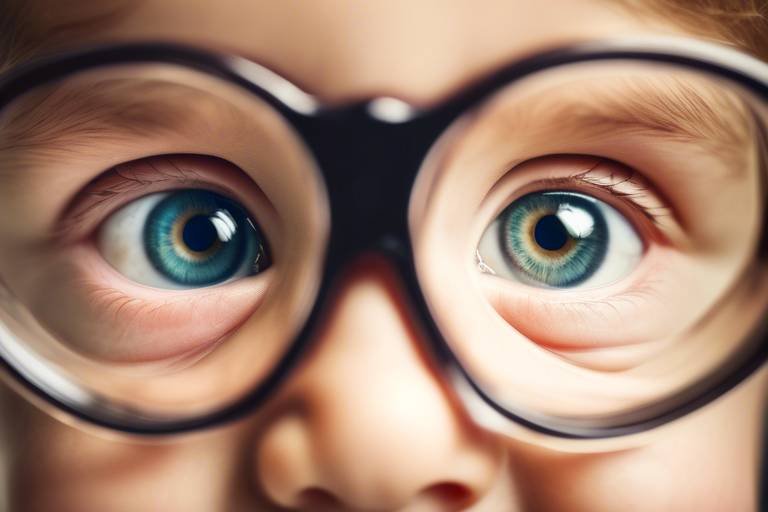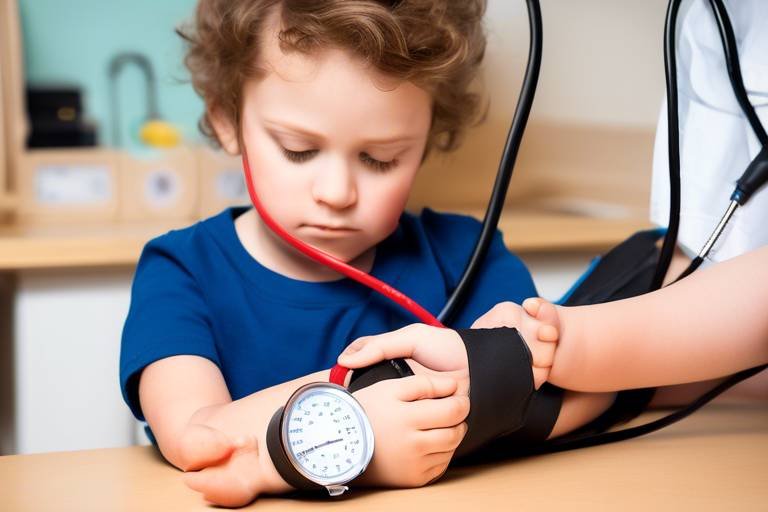Maintaining Healthy Sight for Your Family: An Eye Care Guide
In today’s fast-paced world, where screens dominate our daily lives, maintaining healthy sight for your family is more important than ever. Just think about it: our eyes are the windows to the world, allowing us to experience everything from the vibrant colors of nature to the intricate details of our loved ones’ faces. However, with increasing exposure to digital devices, the risk of eye strain and various vision problems is on the rise. So, how can we ensure that our family's vision remains sharp and healthy? This guide will explore essential tips and practices for preserving eye health, covering everything from regular check-ups to lifestyle choices that promote optimal vision.
Regular eye exams are crucial for detecting vision problems early. They’re like routine check-ups for your eyes, allowing you to catch potential issues before they become serious. But how often should your family get their eyes checked? The answer varies depending on age and individual risk factors. For instance, children should have their first eye exam at six months, then again at three years, and before starting school. Adults, on the other hand, should have comprehensive exams every two years, or annually if they wear glasses or contact lenses. By prioritizing regular eye exams, you’re not just ensuring clear vision; you’re also safeguarding your family’s overall health.
Familiarizing yourself with common eye conditions can empower you to recognize symptoms early and seek appropriate treatment for your family. Conditions such as myopia (nearsightedness), hyperopia (farsightedness), and astigmatism can affect both children and adults. Understanding these terms is crucial because they can significantly impact daily activities like reading or driving. If you notice your family members squinting or struggling to see things clearly, it might be time to consult an eye care professional.
Identifying early signs of vision problems is vital for both children and adults. But how do you know when it’s time to get an eye examination? Here are some key indicators to keep an eye out for:
Children may exhibit specific symptoms such as squinting, rubbing their eyes frequently, or having trouble reading the board at school. If your child complains of headaches after reading or seems to avoid activities that require close vision, these could be signs of an underlying issue. Being proactive can make a world of difference in their academic performance and overall quality of life.
For adults, symptoms like blurred vision, double vision, or frequent headaches can indicate the need for an eye examination. It’s easy to brush off these signs as stress or tiredness, but ignoring them could lead to more significant problems down the line. If you find yourself straining to read small print or experiencing discomfort while using screens, it’s time to take action.
Implementing preventative measures can significantly reduce the risk of eye diseases. Simple lifestyle changes can have a big impact on your family's eye health. Here are a few practical steps you can take:
- Encourage regular breaks from screens using the 20-20-20 rule: every 20 minutes, look at something 20 feet away for 20 seconds.
- Ensure proper lighting when reading or using devices to reduce eye strain.
- Promote outdoor activities; studies show that spending time outside can help reduce the risk of nearsightedness in children.
A balanced diet rich in vitamins and minerals is essential for maintaining healthy eyesight. Just like how a car needs the right fuel to run smoothly, our eyes require specific nutrients to function optimally. Certain vitamins and minerals play a crucial role in supporting eye health, and understanding their benefits can encourage healthier dietary choices.
Vitamins A, C, and E, along with omega-3 fatty acids, are particularly important for eye health. Vitamin A helps maintain good vision, especially in low light, while Vitamin C contributes to the health of blood vessels in the eyes. Vitamin E protects the eyes from oxidative damage, and omega-3 fatty acids are crucial for retinal health. Including these nutrients in your family’s diet can make a significant difference.
Incorporating leafy greens, fish, and colorful fruits into your family's diet can provide essential nutrients for optimal eye health. Here are some delicious options to consider:
- Leafy Greens: Spinach, kale, and collard greens are packed with lutein and zeaxanthin, which can help filter harmful light.
- Fish: Salmon and tuna are rich in omega-3 fatty acids, promoting good vision.
- Colorful Fruits: Carrots, oranges, and berries provide a wealth of vitamins and antioxidants.
Meal planning around these foods not only benefits eye health but also creates a colorful and appealing plate that your family will love!
Q: How often should children have their eyes checked?
A: Children should have their first eye exam at six months, then again at three years, and before starting school.
Q: What are the signs of eye strain?
A: Symptoms include blurred vision, headaches, and difficulty focusing after prolonged screen time.
Q: Can diet really affect eye health?
A: Absolutely! A diet rich in specific vitamins and minerals can significantly improve and maintain eye health.

Importance of Regular Eye Exams
Regular eye exams are not just a good idea; they are absolutely essential for maintaining the vision and overall eye health of your family. Think of your eyes as windows to the world; if those windows get dirty or damaged, your view can become clouded or obstructed. By scheduling routine check-ups, you can catch potential issues before they escalate into serious problems.
So, how often should you and your loved ones visit the eye doctor? Well, it varies by age and individual circumstances. For example:
| Age Group | Recommended Frequency of Eye Exams |
|---|---|
| Children (0-5 years) | Every 1-2 years |
| Children (6-18 years) | Every 1-2 years, or as recommended by a doctor |
| Adults (19-64 years) | Every 2 years, or as recommended |
| Seniors (65 years and older) | Every year |
This table serves as a quick reference guide, but keep in mind that personal health factors can influence these recommendations. For instance, if someone in your family has a history of eye problems or chronic conditions like diabetes, they may need to see an eye care professional more frequently. Don’t wait for symptoms to arise! Regular check-ups can help identify issues like glaucoma, cataracts, or even signs of systemic diseases that can affect vision.
Moreover, eye exams are not just about getting a new prescription for glasses or contact lenses. They are a comprehensive evaluation of your visual health. During an exam, the eye doctor will assess not only how well you see but also the health of your eyes. They may perform tests to check for:
- Eye coordination and alignment
- Depth perception
- Color vision
- Peripheral vision
By understanding the importance of regular eye exams, you’re taking a proactive approach to your family’s health. Just as you wouldn’t skip routine check-ups with your family doctor, don’t overlook the significance of regular eye care. Remember, prevention is always better than cure. So, make those appointments, and ensure that your family’s eyes remain healthy and vibrant!

Common Eye Conditions to Watch For
When it comes to maintaining the vision of your family, knowledge is power. Familiarizing yourself with common eye conditions can be a game-changer, allowing you to recognize symptoms early and seek appropriate treatment. Vision issues can sneak up on us, often without any warning, so understanding what to watch for is essential. Let's dive into some of the most prevalent eye conditions that might affect both children and adults.
Myopia, or nearsightedness, is a condition where distant objects appear blurry while close objects can be seen clearly. This condition often develops in childhood and can worsen as a child grows. If you notice your child squinting at the television or sitting too close to the screen, these could be signs of myopia. On the other hand, hyperopia (farsightedness) is when distant objects are seen more clearly than nearby ones. Adults may experience eye strain or headaches when reading or doing close-up tasks, indicating that they might be dealing with hyperopia.
Another common issue is astigmatism, which occurs when the cornea is irregularly shaped, causing blurred vision at all distances. Symptoms can include difficulty seeing at night and experiencing glare from lights. What’s important to note is that these conditions often coexist; for example, a person can be myopic and have astigmatism at the same time. Being aware of these conditions can help you take proactive steps in seeking treatment.
It's also crucial to recognize the signs of vision problems in both children and adults. For children, symptoms may include:
- Frequent eye rubbing
- Squinting or tilting the head to see better
- Difficulty concentrating on schoolwork or reading
These signs might indicate that it’s time for an eye exam. For adults, the symptoms can be a bit different. Look out for:
- Blurred or double vision
- Frequent headaches, especially after reading or using screens
- Difficulty seeing at night or in low-light conditions
Recognizing these symptoms early can lead to timely interventions, which is vital for maintaining overall eye health. Regular check-ups with an eye care professional can help catch these issues before they escalate, ensuring that your family enjoys a lifetime of healthy vision.
Q: How often should my family get eye exams?
A: The frequency of eye exams can vary by age and risk factors. Generally, children should have their first eye exam at 6 months, again at 3 years, and before starting school. Adults should have an eye exam every 1-2 years, depending on their age and health conditions.
Q: What are some warning signs of serious eye conditions?
A: Warning signs can include sudden vision loss, flashes of light, or seeing floating spots. If you experience any of these symptoms, it's crucial to seek immediate medical attention.
Q: Can diet really affect eye health?
A: Absolutely! A balanced diet rich in vitamins and minerals can significantly impact your eye health. Nutrients like omega-3 fatty acids, lutein, and vitamins C and E are particularly beneficial for maintaining good vision.

Signs of Vision Problems
Recognizing the early signs of vision problems is crucial for both children and adults, as it can lead to timely interventions and better outcomes. Just like a car that starts making strange noises, our eyes can give us hints when something isn't right. Whether it's squinting, headaches, or difficulty focusing, these symptoms should never be ignored. So, what should you be on the lookout for?
For children, the signs can be quite distinct. They might squint frequently or hold their books too close to their faces. This behavior is often a clear indication that their vision isn't as sharp as it should be. Additionally, if your little one is struggling with reading or showing signs of frustration during homework, it might be time to consider an eye exam. Remember, children may not always verbalize their discomfort, so being observant is key.
Adults, on the other hand, may experience symptoms that can easily be brushed off as part of daily life. For instance, blurred vision can occur when staring at screens for too long, but if it becomes a regular occurrence, it's a red flag. Headaches, especially those that happen after long hours of reading or working on a computer, could indicate that your eyes are straining. In some cases, you might notice that colors seem less vibrant or that you have difficulty seeing at night. These signs should prompt a visit to an eye care professional.
Here’s a quick summary of common signs to watch for:
- Children:
- Squinting or closing one eye
- Holding books too close
- Complaining of headaches
- Adults:
- Blurred or double vision
- Frequent headaches
- Difficulty seeing at night
It's essential to foster an environment where discussing eye health is normalized. Encourage your family members to express any discomfort they may experience. Just as we wouldn't ignore a persistent cough or a sore tooth, we shouldn't overlook our vision. By being proactive and aware, you're taking significant steps toward maintaining your family's eye health.
1. How often should I schedule eye exams for my family?
It's recommended that children have their first eye exam at 6 months, then again at age 3, and before they start school. After that, adults should have an eye exam every 1-2 years, depending on their age and health.
2. What are some common symptoms of eye strain?
Symptoms of eye strain can include blurred vision, dry eyes, headaches, and difficulty focusing. If you experience these regularly, consider taking breaks from screens and consulting an eye care professional.
3. Can diet really affect eye health?
Absolutely! A balanced diet rich in vitamins A, C, E, and omega-3 fatty acids can significantly contribute to better eye health. Incorporating colorful fruits and leafy greens into meals can provide the necessary nutrients.
4. What should I do if I notice symptoms of vision problems?
If you or a family member experiences any concerning symptoms, it's important to schedule an eye exam as soon as possible. Early detection can lead to more effective treatment.

Symptoms in Children
When it comes to the eye health of children, being vigilant is key. Children often don't realize they have a vision problem, making it crucial for parents to recognize the signs. One of the most common indicators is squinting. If you notice your child squinting frequently, especially when trying to focus on distant objects, it could signal that they are struggling to see clearly. This action is their way of attempting to improve their vision, but it’s not a long-term solution.
Another symptom to watch for is difficulties with reading. If your child complains about words appearing blurry or if they often lose their place while reading, it might be time for an eye examination. Additionally, headaches can be another red flag. If your child frequently complains of headaches, especially after prolonged periods of reading or screen time, it could indicate that they are straining their eyes.
Moreover, eye rubbing is a common behavior among children, especially if they are experiencing discomfort. While children rub their eyes for various reasons, persistent rubbing may suggest they are having trouble with their vision. It's also important to note any signs of aversion to light. If your child squints or shows discomfort in bright environments, this could be a symptom of an underlying issue.
In some cases, children may also exhibit behavioral changes. For instance, if your child suddenly becomes less interested in activities that require visual focus, such as drawing or playing sports, this could be a sign that they are experiencing vision problems. Parents should also be aware of any signs of poor hand-eye coordination, which might manifest as difficulty catching a ball or trouble with tasks that require precise movements.
To help parents better understand the symptoms, here’s a quick summary of key indicators that may signal a need for an eye examination:
- Frequent squinting
- Difficulties with reading or seeing distant objects
- Complaints of headaches after visual tasks
- Excessive eye rubbing
- Light sensitivity
- Behavioral changes regarding visual activities
- Poor hand-eye coordination
Recognizing these symptoms early can lead to timely interventions, ensuring that your child receives the necessary care to maintain their vision. Remember, the earlier a vision problem is detected, the better the chances for effective treatment and management. So, keep an eye out for these signs and don’t hesitate to consult an eye care professional if you have any concerns!
Q: At what age should my child have their first eye exam?
A: It is recommended that children have their first comprehensive eye exam at around 6 months of age, followed by additional exams at age 3, and again before they enter school.
Q: What should I do if I notice symptoms of vision problems in my child?
A: If you notice any symptoms such as squinting, headaches, or difficulty reading, schedule an appointment with an eye care professional as soon as possible for a comprehensive evaluation.
Q: How often should my child have eye exams?
A: After the initial exams, children should have their eyes checked every 1-2 years, or more frequently if they have existing vision problems or risk factors.

Symptoms in Adults
As we navigate through life, our bodies change, and so do our eyes. It's crucial to recognize the symptoms of vision problems in adults, as early detection can make a world of difference. Have you ever found yourself squinting at the TV or struggling to read the fine print on a menu? These seemingly minor inconveniences could be signs that your eyes need attention. Common symptoms to watch for include:
- Blurred Vision: This is one of the most noticeable symptoms. If you find that your vision isn't as sharp as it used to be, it could indicate a refractive error or other underlying conditions.
- Frequent Headaches: Experiencing headaches, especially after prolonged screen time or reading, might suggest that your eyes are straining to focus.
- Difficulty Seeing at Night: If you struggle to see in low-light conditions, it could be a sign of night blindness or other issues.
- Seeing Halos: If you notice halos around lights, it might indicate cataracts or other refractive errors.
- Eye Fatigue: Prolonged periods of reading or staring at a screen can lead to eye fatigue, often accompanied by dryness or irritation.
These symptoms can often be dismissed as a normal part of aging or simply being tired, but they shouldn't be taken lightly. If you experience any of these signs, it’s time to schedule an eye exam. Remember, your eyes are the windows to your world, and keeping them in good shape is essential for maintaining your quality of life.
Moreover, some symptoms can be indicative of more serious conditions, such as glaucoma or macular degeneration. If you notice sudden changes in your vision, such as flashes of light or a sudden loss of vision in one eye, seek immediate medical attention. It's better to be safe than sorry!
In addition to these symptoms, regular eye exams are a fundamental part of maintaining good eye health. During these visits, your eye care professional can assess your vision and check for any early signs of eye diseases. They say an ounce of prevention is worth a pound of cure—this rings especially true for eye health. So, don't wait until symptoms worsen; make eye care a priority in your life!
Q: How often should adults have their eyes examined?
A: Adults aged 18-64 should have an eye exam every two years, while those over 65 should have annual check-ups. However, if you have existing vision problems or are at risk for eye diseases, more frequent exams may be necessary.
Q: What are some lifestyle changes I can make to improve my eye health?
A: Incorporating a balanced diet, reducing screen time, wearing sunglasses, and taking regular breaks during tasks that require intense focus can all contribute to better eye health.
Q: Are there any specific symptoms I should never ignore?
A: Yes, sudden changes in vision, such as flashes of light, floaters, or loss of vision, should be addressed immediately, as they can indicate serious conditions.

Preventative Measures for Eye Health
When it comes to maintaining healthy eyes, prevention is key. Just like you wouldn’t wait for your car to break down before getting it serviced, the same principle applies to your eye health. Taking proactive steps can significantly reduce the risk of developing serious eye conditions. Here are some essential measures you can incorporate into your family’s routine.
First and foremost, regular eye exams should be at the top of your priority list. These check-ups are not just for those who already wear glasses or contact lenses; they are vital for everyone, including children. A comprehensive eye exam can catch problems before they escalate, ensuring that any necessary treatment can be initiated early. Depending on age and risk factors, it’s recommended to visit the eye doctor every one to two years.
Next, let’s talk about the importance of protective eyewear. Whether your family enjoys sports, gardening, or even just spending time outdoors, wearing appropriate eye protection is crucial. UV-blocking sunglasses can shield your eyes from harmful rays, while safety goggles can prevent injuries during activities that pose a risk. Remember, your eyes are irreplaceable!
Another essential aspect of preventative care is screen time management. In our digital age, screen time is unavoidable, but excessive exposure can lead to digital eye strain. Encourage your family to follow the 20-20-20 rule: every 20 minutes, take a 20-second break to look at something 20 feet away. This simple habit can relieve eye fatigue and discomfort.
Moreover, creating a healthy environment at home can also contribute to eye health. Ensure that your living spaces are well-lit to reduce strain when reading or working on screens. Additionally, consider using an air humidifier if your home is dry, as this can help alleviate dry eyes. A little attention to your surroundings can make a big difference!
Lastly, don’t underestimate the power of hydration and nutrition. Drinking plenty of water and consuming a diet rich in fruits and vegetables can keep your eyes hydrated and nourished. Foods high in antioxidants, such as leafy greens, carrots, and fish, are particularly beneficial. They help combat oxidative stress, which can lead to age-related eye diseases.
In conclusion, taking these preventative measures can significantly enhance your family’s eye health. By prioritizing regular check-ups, using protective eyewear, managing screen time, maintaining a healthy environment, and focusing on nutrition, you can help ensure that your loved ones enjoy clear vision for years to come.
- How often should my family have eye exams? It’s generally recommended that children have their first eye exam at age 1, again at age 3, and then every two years thereafter. Adults should have exams every one to two years, depending on their eye health.
- What are the signs my child might need glasses? Look for signs such as squinting, rubbing their eyes frequently, or difficulty reading the board at school.
- Can diet really affect eye health? Absolutely! A balanced diet rich in vitamins A, C, and E, along with omega-3 fatty acids, can help maintain good eyesight and reduce the risk of eye diseases.
- What should I do if I experience sudden vision changes? If you notice sudden changes in your vision, such as blurriness or flashes of light, it’s crucial to seek medical attention immediately.

Nutrition for Eye Health
When it comes to maintaining healthy eyesight, nutrition plays a pivotal role that often gets overlooked. Just like a car needs the right fuel to run smoothly, our eyes require specific nutrients to function optimally. A balanced diet rich in vitamins and minerals not only supports your overall health but also safeguards your vision. So, what should you be putting on your plate for better eye health?
First and foremost, it’s essential to include vitamins A, C, and E in your diet. These vitamins are known as antioxidants, which help combat oxidative stress that can damage the cells in your eyes. Vitamin A, for instance, is crucial for maintaining good vision, particularly in low light. You can find this vitamin in foods like carrots, sweet potatoes, and spinach. On the other hand, vitamin C is abundant in citrus fruits, strawberries, and bell peppers, and it plays a role in reducing the risk of cataracts. Lastly, vitamin E, found in nuts and seeds, helps protect the eyes from age-related damage.
Another essential nutrient for eye health is omega-3 fatty acids. These healthy fats are known for their anti-inflammatory properties and are vital for maintaining the health of the retina. Studies have shown that omega-3s can help prevent dry eyes and may even lower the risk of macular degeneration. You can boost your omega-3 intake by including fish like salmon, mackerel, and sardines in your diet, or by opting for flaxseeds and walnuts if you prefer plant-based options.
To make it easier for you to understand the best foods for eye health, here’s a quick reference table:
| Nutrient | Sources | Benefits |
|---|---|---|
| Vitamin A | Carrots, sweet potatoes, spinach | Supports night vision and overall eye health |
| Vitamin C | Citrus fruits, strawberries, bell peppers | Reduces risk of cataracts and promotes blood vessel health |
| Vitamin E | Nuts, seeds, green leafy vegetables | Protects eye cells from oxidative damage |
| Omega-3 Fatty Acids | Salmon, mackerel, flaxseeds | Reduces inflammation and supports retinal health |
Incorporating these nutrients into your family’s diet is easier than you might think. Start by planning meals that feature colorful fruits and vegetables, as they are not only visually appealing but also packed with essential vitamins. For example, a vibrant salad with spinach, bell peppers, and a sprinkle of nuts can be both delicious and nutritious. Additionally, consider swapping out red meat for fish a couple of times a week to boost your omega-3 intake.
Don’t forget about hydration! Drinking plenty of water is crucial for maintaining moisture in your eyes, which can help prevent dryness and irritation. Aim for at least eight glasses a day, and consider incorporating herbal teas or infused water for variety.
In conclusion, a nutrient-rich diet is a cornerstone of maintaining optimal eye health for your family. By prioritizing foods that are high in vitamins A, C, E, and omega-3 fatty acids, you can empower your loved ones to protect their vision for years to come. So next time you’re at the grocery store, think about your eyes and fill your cart with the foods that will help keep them healthy!
Q: How often should my family have eye exams?
A: It’s generally recommended that children have their first eye exam at age 1, then again at age 3, and before starting school. Adults should have a comprehensive eye exam every two years, or more frequently if recommended by an eye care professional.
Q: Can a poor diet really affect my eyesight?
A: Absolutely! A diet lacking in essential nutrients can lead to various eye conditions, including macular degeneration and cataracts. Eating a balanced diet rich in eye-friendly nutrients is crucial for maintaining good vision.
Q: Are there any specific foods I should avoid for better eye health?
A: Foods high in sugar and unhealthy fats can contribute to obesity and other health issues, which may indirectly affect eye health. It’s best to limit processed foods and sugary snacks.

Essential Vitamins and Minerals
When it comes to maintaining healthy eyesight, the importance of cannot be overstated. These nutrients act like the unsung heroes of our diet, quietly working behind the scenes to keep our eyes functioning optimally. Just as a car needs fuel to run smoothly, our eyes require specific nutrients to stay healthy. So, what exactly should you be looking for in your family’s meals?
First and foremost, Vitamin A is a powerhouse for eye health. It plays a crucial role in maintaining the retina's ability to absorb light, which is essential for clear vision. You can find Vitamin A in foods like carrots, sweet potatoes, and spinach. Imagine your eyes as a camera; without enough Vitamin A, the lens becomes cloudy, and the images you see can become blurry.
Next up is Vitamin C, known for its antioxidant properties. This vitamin helps protect the eyes from damage caused by free radicals, which can contribute to age-related eye conditions. Citrus fruits, strawberries, and bell peppers are excellent sources of Vitamin C. Think of it as a shield for your eyes, keeping harmful elements at bay.
Vitamin E is another vital nutrient that acts as an antioxidant, working alongside Vitamin C to protect the eyes. You can find Vitamin E in nuts, seeds, and green leafy vegetables. It’s like a protective blanket for your eyes, helping to ward off oxidative stress and inflammation.
Let’s not forget about omega-3 fatty acids. These healthy fats are essential for maintaining the health of the retina and can help prevent dry eyes. Fish like salmon and sardines are rich in omega-3s, making them an excellent choice for family dinners. Think of omega-3s as the lubricants that keep everything running smoothly, ensuring your eyes stay moist and comfortable.
To give you a clearer picture of these essential nutrients, here’s a quick overview:
| Nutrient | Benefits | Food Sources |
|---|---|---|
| Vitamin A | Maintains retina health | Carrots, sweet potatoes, spinach |
| Vitamin C | Protects against free radicals | Citrus fruits, strawberries, bell peppers |
| Vitamin E | Acts as an antioxidant | Nuts, seeds, green leafy vegetables |
| Omega-3 Fatty Acids | Supports retina health and prevents dry eyes | Salmon, sardines, flaxseeds |
Incorporating these vitamins and minerals into your family’s diet doesn’t have to be a chore. With a little planning, you can create delicious meals that are both nutritious and appealing. For instance, consider making a vibrant salad filled with leafy greens, colorful bell peppers, and a sprinkle of nuts. Not only does it look appetizing, but it’s also a powerhouse of nutrients that your eyes will thank you for!
In conclusion, ensuring your family gets enough of these essential vitamins and minerals is a simple yet effective way to promote long-term eye health. By prioritizing these nutrients in your diet, you’re not just feeding your body; you’re also nurturing your vision for years to come.
- What are the best foods for eye health? Foods rich in Vitamins A, C, E, and omega-3 fatty acids are excellent for eye health.
- How often should my family get eye exams? It's recommended to have regular eye exams every one to two years, depending on age and existing conditions.
- Can eye health be improved through diet alone? While a healthy diet is crucial, regular check-ups and protective measures are also necessary for optimal eye health.

Foods to Include in Your Diet
When it comes to maintaining optimal eye health, what you put on your plate can make a world of difference. Think of your body as a high-performance vehicle; just like a car needs the right fuel to run smoothly, your eyes require specific nutrients to function at their best. So, let’s dive into some fantastic foods that should be staples in your family’s diet!
First on the list are leafy greens. Vegetables like spinach, kale, and collard greens are packed with lutein and zeaxanthin, two powerful antioxidants that help filter harmful blue light and reduce the risk of age-related macular degeneration. Imagine these nutrients as your eyes' personal bodyguards, standing watch against the damage that can occur over time.
Next up, we have fish, particularly those rich in omega-3 fatty acids, like salmon, mackerel, and sardines. Omega-3s are crucial for maintaining the health of the retina and can help prevent dry eyes. Think of omega-3s as the oil that keeps the gears of your eye functioning smoothly. If you’re not a fan of fish, consider incorporating flaxseeds or walnuts into your meals, as they are excellent plant-based sources of omega-3s.
Don’t forget about colorful fruits! Oranges, berries, and carrots are not just tasty but are also loaded with vitamins that are essential for eye health. For instance, carrots are high in beta-carotene, which your body converts to vitamin A—a nutrient that is vital for good vision. Picture your eyes as a camera; vitamin A helps maintain the lens and the retina, ensuring that everything stays in focus.
To give you a clearer picture of how these foods stack up in terms of their eye health benefits, take a look at the table below:
| Food | Key Nutrients | Eye Health Benefits |
|---|---|---|
| Spinach | Lutein, Zeaxanthin | Reduces risk of macular degeneration |
| Salmon | Omega-3 Fatty Acids | Prevents dry eyes, supports retina health |
| Carrots | Beta-Carotene | Essential for good vision |
| Berries | Vitamin C | May lower risk of cataracts |
Incorporating these foods into your family’s meals doesn’t have to be a chore. Try blending spinach into smoothies, grilling salmon for a delicious dinner, or snacking on berries for a sweet treat. The key is to make it fun and enjoyable. After all, when you’re feeding your family healthy foods, you’re not just nourishing their bodies but also their vision!
So, next time you're at the grocery store, remember to stock up on these eye-friendly foods. Your family’s eyesight will thank you for it!
1. How often should I include these foods in my diet?
It's best to incorporate these eye-healthy foods into your meals regularly. Aim for at least a few servings of leafy greens and fish each week, while fruits can be enjoyed daily.
2. Can supplements replace these foods?
While supplements can help, they shouldn't replace whole foods. Whole foods provide a range of nutrients that work synergistically to promote eye health.
3. What are some easy recipes to include these foods?
Consider making a spinach salad with salmon, blending a berry smoothie, or roasting carrots with herbs for a delicious side dish.
Frequently Asked Questions
- How often should my family get eye exams?
It's recommended that children have their first eye exam at 6 months and then at age 3, followed by yearly check-ups. For adults, a comprehensive eye exam should be done every two years, or annually if you have existing vision problems or are over 60.
- What are the signs that my child may need an eye exam?
Watch for signs like squinting, difficulty focusing on objects, or complaints about blurry vision. If they frequently rub their eyes or seem to have trouble reading, it's time to schedule an eye exam.
- What common eye conditions should I be aware of?
Some common conditions include myopia (nearsightedness), hyperopia (farsightedness), and astigmatism. Familiarizing yourself with these can help you recognize symptoms early and seek treatment.
- Can diet really affect eye health?
Absolutely! A balanced diet rich in vitamins A, C, and E, as well as omega-3 fatty acids, can significantly benefit your eye health. Foods like leafy greens, fish, and colorful fruits should be staples in your family's diet.
- What are the best foods for eye health?
Incorporate foods such as spinach, kale, carrots, and fatty fish like salmon into your meals. These foods are packed with essential nutrients that support optimal vision.
- What symptoms in adults indicate a need for an eye exam?
Adults should be alert for symptoms like blurred vision, frequent headaches, or difficulty seeing at night. If you experience any of these, it's wise to consult an eye care professional.
- How can I prevent eye diseases in my family?
Preventative measures include regular eye exams, protecting eyes from UV light with sunglasses, maintaining a balanced diet, and managing chronic conditions like diabetes that can affect vision.



















